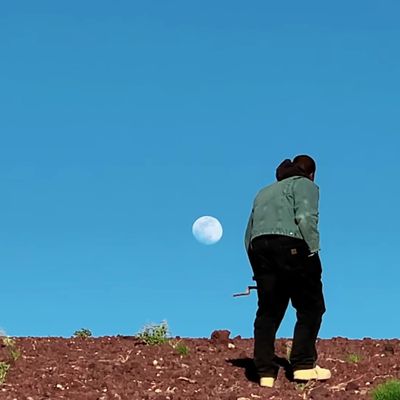
It goes without saying that the Jesus Is King film is intended for Kanye West devotees. Offering up a 35-minute art film for the price of an IMAX ticket is the kind of approach that does a pretty good job of separating the hardcore fans from the merely curious. At the nearly sold-out 7 p.m. screening at Lincoln Square AMC last night (home to the only true IMAX screen in New York City, accept no substitutes), the audience looked to be made up mostly of admirers, with a light but not inconsiderable scattering of journalists. Anyone who’s stuck with West over the wild highs and lows of his tumultuous career has had to cultivate a kind of superhuman patience, and this latest output cycle is no different. Jesus Is King is meant to be a companion piece to the album of the same name, one that blew through three announced release dates and only just made its arrival this afternoon.
That’s good news for the movie, which isn’t the kind of thing that benefited from being put out into the world solo — it’s an experimental effort that feels too ethereal to bear up under much solo scrutiny. The Jesus Is King movie isn’t anything like Runaway, the 2010 short that West directed and starred in himself, and released ahead of My Beautiful Dark Twisted Fantasy. Jesus Is King offers little by way of narrative at all, existing in a space somewhere between that of visual album and concert doc. West has handed the directorial reins over to Nick Knight, who helmed the videos for “Bound 2” and “Black Skinhead,” but the authorship of the project is clearly still all Kanye’s — a mix of ecstatic spirituality and artistic wankery. More than anything else, the film feels like a frustrated attempt at conveying a concentrated version of its born-again creator’s experiences, before he pulls away and turns with a degree of relief back to the topic he’s always been more comfortable with — himself.
Jesus Is King was shot in the Roden Crater, an ongoing, unfinished land art installation on the edge of the Painted Desert that’s never been open to the public, and that James Turrell has been working on since the late ’70s. It’s a spectacular setting, even if the film quickly reveals itself to be overly enamored with the landform’s shape — Jesus Is King starts off with a drone shot that slowly pulls away from its round structure from above, and then uses circles as the central visual motif, and frame shape, for most of the remaining runtime. Circles within circles, even, once it heads into the structure, where it stays. The main space, the Crater’s Eye, is a round room with a round cutout in the middle of the ceiling offering a domelike view of the bright Arizona sky. It’s a place that has the atmosphere of a cathedral without actually being one, which is ideal for a movie that wants to summon the feeling of church — down to periodic Bible verses appearing on screen — without the structure of it.
When the Sunday Service choir — the group West assembled for the weekly pseudo-religious performances he’s been leading all year — files onto the screen in matching costumes, they sing the words “Jesus is king” to the tune of Carl Orff’s “O Fortuna,” that go-to music cue for whenever shit’s going down in a movie. It’s goofy as hell, but it’s a little goosebump-inducing, too, when the choir members pause between phrases to let their harmonies reverberate off the walls of the room. The film freely mixes a few tracks from the new album with older material off The Life of Pablo and 808s & Heartbreak, and all of that with gospel songs and hymns. It focuses at first on the choir, sometimes from unexpected angles — one singer gets a direct, prolonged close-up, which is an awfully intense thing to do to a person in IMAX, the circular framing making her look like a massive Twitter avatar. The members reach to the heavens and kneel as if in prayer as they perform, but as much as Jesus Is King tries to borrow their devotional exuberance — shooting the choir director from below so that his energetic conducting is framed against the sky — it also feels outside of it. The film is never more vivid than when most of them depart the frame.
That’s when West, who over the course of Jesus Is King goes from member of the group to soloist, makes his way into a sequence that’s staged like the aftermath of a show, and offers a spare, haunting rendition of “Street Lights,” accompanied on piano and organ, that’s easily the highlight of the whole affair. The sequence after that is even more intimate — a shot of Psalm West cradled against his father’s chest as he sings an a capella version of his new track “Use This Gospel.” It’s there, at its more minimal, where Jesus Is King ends. And if that’s abrupt, well, nothing about the film is especially coherent, including its simultaneous status as a piece of art, a gesture of religious conviction, and a shameless act of commerce. It feels like notes from an artist who’s not sure if he wants to express himself as a worshiper or an object of worship — but who’s prepared to give it a try anyhow, on the biggest screen possible.


